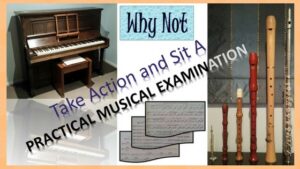Sitting a Practical Music Examination
So you want to sit a practical music examination but don’t know what you need to do. Read on for some information. But remember if you decide to do one you need to remember the three P’s…..Play Play Play. Consistency is key.
Who Can You Do Your Exam With?
There are different examination boards you can do your exam with, such as Trinity College of London, ABRSM, ANZCA and NZMEB. Each will have their own requirements. It does not matter which one you do as doing a practical music exam gives a student a chance to practice to a performance level and to get feedback from another source. It is usually what your teacher uses.
You may want to do your own research to find the cheapest option or a session time to suit you the best or a preferred syllabis of classical or a more modern styles.
I usually send students to sit Trinity College Music Exams but have had a few sit the ABRSM exams.
Read below for more details on the Trinity College Music exams.
Trinity College of London
I will go over the requirements of the Trinity College of London designed to help individuals develop their as musicians by assessing a broad range of musicianship skills. You can get specifics for your instrument by visiting the website specific to your country eg click for New Zealand here.
For New Zealand candidates click titles for the 2022 exam sessions and closing dates, fees and entry forms.
When are the examinations?
There are generally 2 or 3 times a year when you can enter an exam and you have to fill out a form yourself or through your teacher and get it into your local Trinity Representative by the due date.
The Syllabus
You can download the
latest piano syllabus and free sample booklet here
latest woodwind and jazz woodwind syllabus here
This includes flute, oboe, clarinet, bassoon, saxophone and recorder
The syllabus contain everything you need to know to be successful in the examination, including the criteria used in marking, so have a good read and strive for the best you can.
Requirements
1. Play Three Pieces 22 marks each piece
There is a set list of pieces for each grade. For the final piece there is an option to do a composition, but you will be marked on your performance rather than the composition.
It is a good idea to try as many pieces as you can to pick the best choice for you. Choose a variety of genres to get a balanced program. Different pieces suit different individuals.
Listen to the Pieces
It is a good idea to listen to the pieces if you can, to see which ones you prefer. This can be from your teacher, youTube ,CD’s. This is also good to do if you have a time restriction on learning your exam material.
Find the Music
All pieces are to be performed on the original music ie no photocopies are allowed.
You can either borrow or purchase from your local music shop or online. Often your local music shop do not stock a wide range of the music on the list for viewing. The shops can order whatever you want in but then you may feel obliged to purchase it and it can get expensive.
There may be a book which has several of the pieces on the list.
2. Technical Work 14 marks
This consists of a set of scales and arpeggios and exercises. eg piano scales and arpeggios
and flute scales and arpeggios.
And you get a specific book which has the criteria for each grade.
3. Supporting Tests 2 x 10 marks
Candidates have to pick 2 supporting tests out of a list of four.
These are:
1. Sight Reading: This test assesses the candidates’ ability to perform an unseen musical extract, at a level approximately two grades lower than the exam being taken.
2. Aural: This test supports the development of candidates’ abilities in the field of musical perception by assessing their responses to carefully grades questions.
3. Improvisation: This test assesses candidates’ ability to improvise fluently, coherently and creatively in response to a musical stimulus.
4. Musical Knowledge: This test assesses candidates’ understanding of the pieces being performed, as well as their knowledge of notation and their instrument. It does this by assessing their responses to carefully graded questions based on candidates’ three chosen pieces.
In order to make an informed choice I, as a teacher, would go over each test so the candidate knows all the requirements and then choose the best two.
The parameters for each test are on the Trinity College Website.
The Marks
There is criteria and a pass mark for each test. Examiners give a mark and a comment for each test.
The total for the exam is:
pieces: 3 x 22 = 66
technical: 14
supporting tests: 20
TOTAL : 100
You need the following:
87-100% for Distinction
75-86% for Merit
60-74% for Pass
49-51% for Below Pass 1
0-44% for Below Pass 2
You should get your marks within the next month depending on when your exam was. If your exam was on the last day then you may only have to wait a few days.
The Examination
Your Examination Day
On the day of your practical music examination you arrive to your exam at least 15 minutes earlier than your given time.
There will be a waiting area for you to warm up your instruments and just relax yourself as much as possible before hand.
It’s Time for Your Examination
You will be ushered when it is time. Just respond to everything the examiner asks you to do. He or she will welcome you and try and relax you.
After you say “Hello” to each other the examiner will just go through the program generally starting with pieces first then technical then the supporting tests. However you may be given a choice.
After each test the examiner will make notes then ask you to do the next test. There will be no comments or chitchat about your performance. You have no idea what they are thinking or scribbling on the page. At the end they will generally Thank You. You walk out either thinking of ALL your mistakes or How Easy that was to do and maybe you could consider doing the next grade!!
Your Perception of the Examiner
A candidates perception of the examiner can vary. And you can’t judge how they are going to mark. Sometimes you might think that an examiner who chats a little at the start and smiles more could be a friendlier easier marker than the more serious stern examiners.
Take a look at the following cross stitch I did of how students Perceive Examiners in a Practical Music Examination.
Just remember, examiners are hearing repeats of the same piece or scale. If you have heard 10 clarinets playing the same sort of scales in a day then you too may look like the dog on the left or maybe that is the perception of the student at a particular time.
The lovely cat lady on the right has a job to do …to listen mark and comment and not anything else. Some students may be terrified by the lack of feedback and facial expressions the examiners give…but yes they can’t give you feedback apart from on the piece of paper they are writing on. The facial expression of cat lady does not mean she is going to be an evil marker.
Should I Take a Practical Music Examination?
It is worth trying a Practical Music Examination as it gives you a goal to work towards and may be the inspiration you need to practise. I find that when you DO practise you DO improve and thus provides an increased enjoyment level as you can play a greater variety of pieces.
So Take Action and start Practising towards a Practical Music Examination Today.
If you need practical lessons in flute, recorder, piano or keyboard then you can Enrol Here.
And contact me if you have any questions.
.

